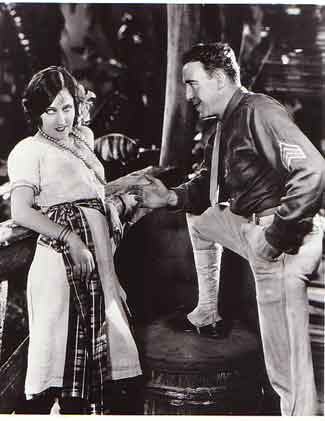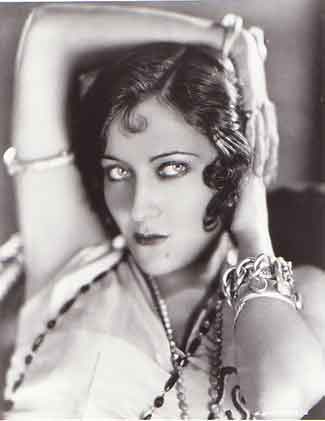|
SADIE THOMPSON (&
CU SYMPHONY)
|
Program
notes by Kristin Thompson, Dept. of Communciation Arts, University
of Wisconsin-Madison
To modern audiences, Gloria Swanson is Norma
Desmond, the deluded aging screen star in Billy Wilder’s
acerbic 1950 classic, Sunset Boulevard. Longing for an
impossible comeback (or “return,” as she insists
on calling it), she famously declares of silent movies, “We
didn’t need dialogue. We had faces!”
Sadly, most audiences today can’t fully appreciate that
line, never having seen one of Swanson’s star turns from
the silent era. Sunset Boulevard came along only a couple
of decades after Swanson’s career fizzled with the coming
of sound. In 1950, many film-goers would still have known
exactly what she meant. The revival of films like Sadie
Thompson allows the current generation to discover Swanson’s
career in its heyday. In fact, Sunset Boulevard brought
the actress her third Oscar nomination. Her first nomination
was for Sadie Thompson. (Her second was in 1929, for
Edmund Goulding’s The Trespasser—a lesser film
restored by George Eastman House a few years ago.)
|
Swanson started her
career in the mid-1910s acting in comic shorts for Mack Sennett’s
Keystone. Her rise to fame came with a series of roles
in sophisticated and sometimes risqué social comedies
by Cecil B. De Mille, including Male and Female and Why Change
Your Husband (both 1919). By the late 1920s, Swanson was
an extraordinarily popular star and was powerful enough to produce
her own films.
The distribution firm United Artists, which released Sadie Thompson,
is usually associated with its four founders, D. W. Griffith, Douglas
Fairbanks, Charlie Chaplin, and Mary Pickford. The company
also distributed independently produced films with other stars,
including Buster Keaton and Rudolph Valentino (such as last year’s
silent film, The Eagle). Sadie Thompson was one of Swanson’s
UA films, as was the abortive Queen Kelly (directed by Erich von
Stroheim and used as the film Desmond shows Joe Gillis in Sunset
Boulevard). It was based on W. Somerset Maugham’s story, “Miss
Thompson,” published in 1921 and based on a real incident
that the author had witnessed in 1916 during a South Seas journey. Its
director, Raoul Walsh, had begun his career in 1915 with the extraordinary
film about slum life and redemption, The Regeneration—subject
matter with distinct parallels to Sadie Thompson. Walsh went
on to direct many major popular-genre films of the sound era, including
the gangster pictures The Roaring Twenties (1939) and White Heat
(1949).
|
The review praises
the performances of Swanson, Lionel Barrymore as the hypocritical
reformer, and Raoul Walsh as the Marine who woos Sadie. “Mr.
Walsh introduces just the right note of rugged health, of real
impending salvation for Sadie from the abnormal shadow that pursues
her under the delusion of saving her soul. You understand
how this humble soldier loves Sadie and how she loves him, and
that is something you often cannot understand about the hero
and heroine of the average picture.” Indeed, given
how short the film is, the relationship between these two develops
with a remarkably natural liveliness that makes the ending all
the more touching.
During the 1960s, the history of the silent cinema was only beginning
to be explored. Sadie
Thompson was largely forgotten, and yet the pioneering film historian George
C. Pratt, then Associate Curator of George Eastman House, included a review of
the film in his teaching packet for a silent-film course at the University of
Rochester—a packet that later became Spellbound in Darkness (1966), a seminal
collection of texts on the era. That review, which had appeared in the
National Board of Review Magazine in February of 1928, characterized Sadie Thompson
as being unusual in “telling a story of meaning and interest to the mentally
adult motion picture-goer.” (Complaints about films being aimed at
kids are not as recent in origin as we might think!) |
 |
Sadie
Thompson had excellent production values. One of Hollywood’s
finest art directors, William Cameron Menzies (who also designed
The Eagle), created the sets, and one of the cinematographers,
George Barnes (who also filmed The Eagle) went on to an impressive
career that included Busby Berkeley musicals like Gold Diggers
of 1935 and Alfred Hitchcock’s Rebecca.
The pictorial riches created by such artists are obscured in some
stretches by the deterioration of the print. Many silent
films have been lost due to the tendency of pre-1950s nitrate-based
stock to corrode. Watching Sadie Thompson, we can see just
how close it came to disappearing forever. Fortunately it
was rescued, and Kino International has assembled still photographs
and scraps of footage to reconstruct the missing ending. Despite
its occasional physical flaws, Sadie Thompson shines through as
a beautifully filmed, marvelously acted, and surprisingly sophisticated
creation of the late silent era.
Maugham’s story has also been published as “Rain,” and
Lewis Milestone directed another excellent adaptation of it in
1932 under that title, starring Joan Crawford as Sadie. Seldom
have the same story and the same role been so well rendered on
film only a few years apart.
|

|
The Creation of the Sadie Thompson Film Score
by Barbara Hedlund, CUSO Principal Cellist/Director
1st Choice Music Services
In 1984, Kino International purchased the rights to the 1928
silent film Sadie Thompson from Gloria Swanson's estate.
To commemorate the film's restoration and video release two years
later, Kino commissioned award-winning composer Joseph Turrin
to create a new musical score.
No stranger to film scoring, the Emmy and Grammy nominee accepted
the challenge. Writing a new soundtrack allowed Joseph Turrin
to relive a part of film history and create the only totally
original score for a silent film. In the Silent
Film Era, most scores were improvised on the spot by the organist, pianist, or
a small pit orchestra which played previously composed and published classical
music.
The 97-minute score is written for conductor and 18 players (two flutes with
a piccolo double, one oboe, two clarinets with a bass clarinet double,
two bassoons, two horns, two trumpets, two trombones, two celli, one double bass,
a piano, and percussion).
|
For conductors and musicians, accompanying
a silent film is a challenging, exciting and sometimes strenuous
experience. The intricacies of accompanying with precision timing
and underscoring dramatic intricacies are particularly demanding
upon the conductor. Film accompaniments require the same skills
and flexibility to
accompany a concert soloist, singer or dancer in the opera or musical theater.
Projection of silent films with live music accompaniment offers audiences a look
back into the silent film era and helps enhance their viewing and audio experience.
The Champaign Urbana Symphony invites you to enjoy the show!
|
|


